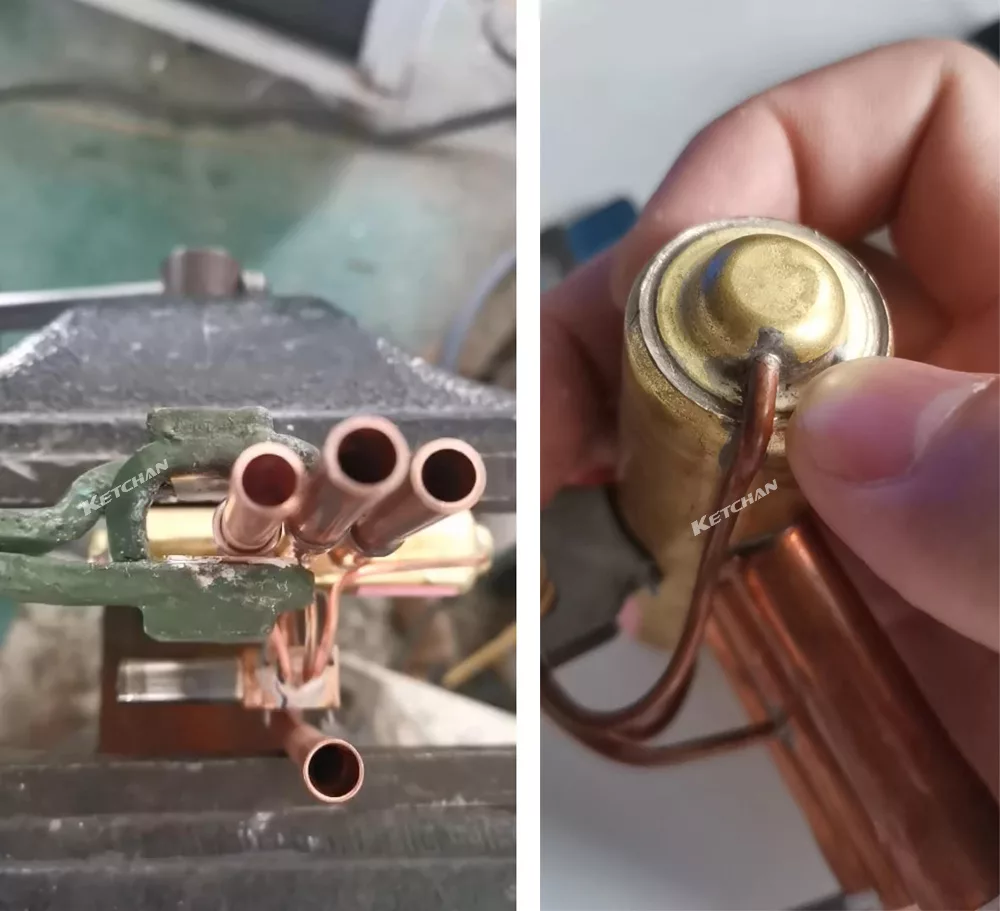Induction soldering of the brass valve and copper tubing is a process of joining these metal parts using a filler metal (solder) that melts and flows into the joint interface at a lower temperature than the base metals. Induction soldering heats the parts with an electromagnetic field that induces eddy currents and generates heat within the parts¹. Induction soldering has many advantages over traditional torch soldering, such as faster heating, precise heat control, selective heat, production line adaptability and integration, improved fixture life and simplicity, repeatable and reliable soldered joints, and improved safety.
To perform induction soldering of the brass valve and copper tubing, you will need an induction soldering machine, a coil, a solder filler metal, and a flux. The steps are as follows:
- Clean the parts to be soldered and apply flux to prevent oxidation and facilitate wetting.
- Place the parts in the coil and position the solder filler metal near the joint. The coil can be custom-made to fit the shape and size of the parts and provide uniform heating.
- Turn on the induction soldering machine and adjust the power and time settings to achieve the desired temperature and heating cycle. The machine should have a precise control system to ensure consistent results.
- Monitor the soldering process and observe the filler metal flow into the joint. You can use a pyrometer or a temperature indicator to check the temperature of the parts.
- Turn off the machine and let the parts cool down naturally or with forced air or water. Do not move the parts until they are solidified to avoid cracking or weakening the joint.
- Remove any excess flux or filler metal with a wire brush or a chemical solution. Inspect the joint for any defects or leaks.
You can also use automation or robotics to perform induction soldering of the brass valves and copper tubing for higher productivity, accuracy, and safety. You can program a robot to move the coil or the parts according to a predefined path and speed. You can also integrate sensors and feedback systems to monitor and adjust the soldering parameters in real time.

What are the advantages of induction soldering?
Some of the advantages of induction soldering are:
- Faster heating cycles: Induction soldering creates heat within the parts rather than on the surface, which reduces the heating time and energy consumption.
- Precise heat control: Induction soldering allows you to adjust the power and time settings to achieve the desired temperature and heating cycle. You can also use sensors and feedback systems to monitor and regulate the soldering parameters in real-time.
- Selective heat: Induction soldering allows you to heat only the joint area without affecting the rest of the assembly. This minimizes distortion, metallurgical changes, oxidation, and carbon buildup on the parts.
- Production line adaptability and integration: Induction soldering equipment can be easily configured for manual, semi-automatic, or fully automatic soldering processes. You can also use robotics, conveyors, carousels, or shuttles to move and position the parts efficiently and accurately.
- Improved fixture life and simplicity: Induction soldering does not require complex fixtures or clamps to hold the parts in place. The coil can be designed to fit the shape and size of the parts and provide uniform heating.
- Repeatable, reliable soldered joints: Induction soldering produces consistent results with high quality and strength of the joints. You can also reduce or eliminate the use of flux or protective atmosphere by using induction soldering.
- Improved safety: Induction soldering eliminates open flame, which reduces the risk of fire, burns, fumes, or gas leaks. Induction soldering also creates a cooler and quieter working environment.
Induction soldering has varied applications in many industries that require joining metal parts with a filler metal at a lower temperature than the base metals. Some of the industries that use induction soldering are:
- Automotive: Induction soldering is used to join various components such as wires, connectors, sensors, switches, terminals, and fuses in cars, trucks, buses, motorcycles, and other vehicles.
- Circuit board: Induction soldering is used to attach electronic components such as resistors, capacitors, transistors, diodes, LEDs, and ICs to printed circuit boards (PCBs) or flexible circuits.
- Piping: Induction soldering is used to join copper or brass pipes and fittings for plumbing, heating, cooling, or refrigeration systems.
- Jewelry: Induction soldering is used to join precious metals such as gold, silver, platinum, or palladium for making rings, earrings, necklaces, bracelets, and other ornaments.
- HVAC: Induction soldering is used to join copper tubing and brass valves for heating, ventilation, and air conditioning (HVAC) systems.
Tags:handheld induction soldering, handheld induction soldering machine, induction heating, induction soldering, induction soldering equipment, induction soldering machine, Induction Soldering of Brass Valve and Copper Tubing, induction soldering of steel to brass, induction soldering of Valve, KETCHAN, KETCHAN Electronic, Manufacturers, price, Soldering and brazing of copper and copper alloys, soldering copper, soldering copper wire, Soldering Copper Wire Connectors, soldering flux, soldering of Brass Valve and Copper Tubing, Suppliers, Zhengzhou KETCHAN, Zhengzhou KETCHAN Electronic
